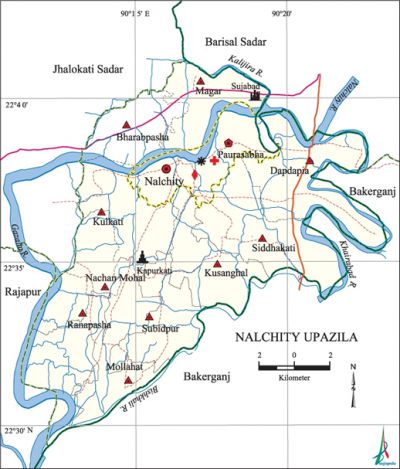Nalchity Upazila
Nalchity Upazila (jhalokati district) area 237.17 sq km, located in between 22°29' and 22°42' north latitudes and in between 90°11' and 90°23' east longitudes. It is bounded by jhalokati sadar and barisal sadar upazilas on the north, bakerganj upazila on the south, Barisal Sadar and Bakerganj upazilas on the east, rajapur and Jhalokati Sadar upazilas on the west.
Population Total 214418; male 105579, female 108839; Muslim 203868, Hindu 10438, Buddhist 87 and others 25.
Water bodies Main rivers: nalchity, bishkhali, Khairabad, Gazalia, Kalijira.
Administration Nalchity Thana was formed in 1924 and it was turned into an upazila in 1983.
| Upazila | ||||||||
| Municipality | Union | Mouza | Village | Population | Density (per sq km) | Literacy rate (%) | ||
| Urban | Rural | Urban | Rural | |||||
|
1 |
10 |
133 |
135 |
35278 |
179140 |
904 |
66.0 |
62.5 |
| Municipality | ||||||||
|
Area (sq km) |
Ward |
Mahalla |
Population |
Density (per sq km) |
Literacy rate (%) | |||
|
24.16 |
9 |
21 |
35278 |
1460 |
65.97 | |||
| Union | ||||
| Name of union and GO code | Area (acre) | Population | Literacy rate (%) | |
| Male | Female | |||
|
Kulkati 21 |
4973 |
8611 |
8962 |
59.84 |
|
Kusanghal 31 |
4437 |
7938 |
8354 |
58.23 |
|
Dapdapia 15 |
7726 |
14337 |
14645 |
66.30 |
|
Nachan Mohal 52 |
3418 |
7335 |
7764 |
59.52 |
|
Bharabpasha 13 |
3743 |
8562 |
8470 |
62.96] |
|
Magar 42 |
6034 |
8836 |
9378 |
62.39 |
|
Mollahat 36 |
4824 |
8885 |
8968 |
64.16 |
|
Ranapasha 73 |
4251 |
6843 |
7083 |
58.39 |
|
Siddhakati 84 |
6802 |
8326 |
9110 |
65.70 |
|
Subidpur 94 |
3948 |
8234 |
8499 |
63.60 |
Source Bangladesh Population Census 2001, Bangladesh Bureau of Statistics.

Archaeological heritage and relics Sujabad Kella (1639), Civil Court Building (1781), Tara Temple and Zamindar Bari (Baroikaran).'
Historical events 19 Muslims were killed in an encounter with the British army in a mosque compound at village Kulkati village in 1927. On 13 May 1971 the Pak army shot 13 persons of this upazila dead. On 30 June at mid night the freedom fighters raided the Nalchity Police Station in which Muktijoddha Yunus was killed. Nalchity upazila was liberated on 8 December.'
Marks of the War of Liberation Mass killing site 2.
Religious institutions Mosque 308, temple 48, church 1, tomb 3, sacred place 1. Noted religious institutions: Mollikpur Jami Mosque, Kulkati Jami Mosque, Kapuria Temple, Tara Temple.
Literacy rate and educational institutions Average literacy 63.1%; male 64.8%, female 61.5%. Noted educational institutions: Nalchity Merchants High School (1929), Siddhakati Secondary School (1882), Chandrakanta Secondary School (1928), Rajapur Pilot High School (1927), Roypur Syed Abdul Latif Secondary School (1927), Nalchity Islamia Fazil Madrasa (1910).
Newspapers and periodicals Nalchity Barta, Sugandha Barta, Sandesh, Bithika, monthly Sujabad.
Cultural organisations Club 22, library 6, sporting club 25, cinema hall 1, theatre group 2, playground 60.
Main sources of income Agriculture 41.01%, non-agricultural labourer 5.43%, commerce 16.33%, transport and communication 2.67%, service 16.91%, construction 1.85%, religious service 0.28%, rent and remittance 1.74% and others 13.78%.
Ownership of agricultural land Landowner 70.01%, landless 29.99%; agricultural landowner: urban 54.13% and rural 73.18%.
Main crops Paddy, pulse, wheat, maize, felon, potato, vegetables.
Extinct or nearly extinct crops Tobacco, jute, sesame, linseed.
Main fruits 'Mango, blackberry, jackfruit, betel nut, coconut, banana.
Fisheries, dairies and poultries This upazila has a number of fisheries, dairies, poultries and hatcheries.
Communication facilities Pucca road 72 km, semi-pucca road 17 km, mud road 112 km.
Extinct or nearly extinct traditional transport 'Goyna and panshi boats.
Noted manufactories Ice factory, rice mill, saw mill, welding factory.
Cottage industries Weaving, bamboo and wood work, tailoring.
Hats, bazars and fairs Hats and bazars are 11, fairs 3.
Main exports Paddy, coconut, betel nut.
Access to electricity All the wards and unions of the upazila are under rural electrification net-work. However 17.43% of the dwelling households have access to electricity.
Sources of drinking water 'Tube-well 87.38%, pond 8.46%, tap 0.32% and others 3.84%. The presence of arsenic has been detected in shallow tube-well water of the upazila.
Sanitation 47.84% (rural 44.32% and urban 65.47%) of dwelling households of the upazila use sanitary latrines and 46.38% (rural 50.29% and urban 26.82%) of dwelling households use non-sanitary latrines; 5.78% of households do not have latrine facilities.
Health centres Upazila health complex 1, family planning centre 8, community clinic 14.
Natural disasters Many people were victims of the floods of 1786 and cyclones and tidal bores of 1822, 1909 and 1970. These natural disasters also caused heavy damages to settlements, livestock and crops of the upazila.
NGO activities Palli Unnayan Sangstha, brac, asa. [Md. Mizanur Rahman]
References' Bangladesh Population Census 2001, Bangladesh Bureau of Statistics; Cultural survey report of Nalchity Upazila 2007.
